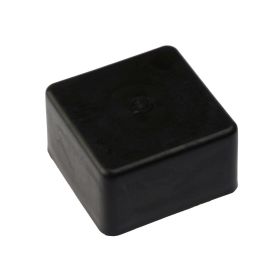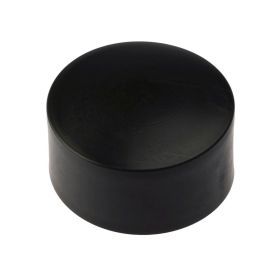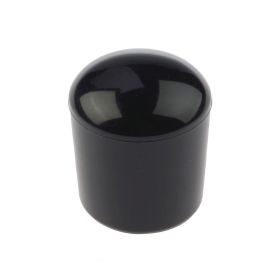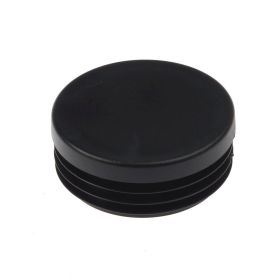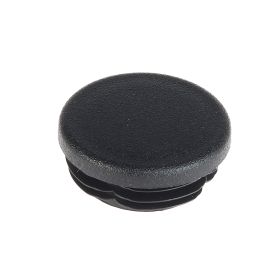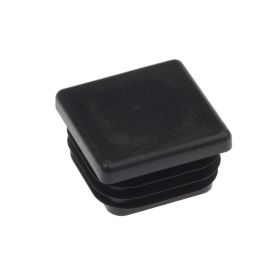Types and Sizes of Plastic End Caps
Round and square plastic caps are manufactured to match the geometry of standard tube profiles. External models slide over the post and provide a flush finish when the cut edge is clean and
dimensions are consistent. Insert types are pressed into the opening and secured by a ribbed or lamellar body that compresses against the internal wall. This construction allows stable placement where the post is slightly deformed or unevenly cut. Shape, wall thickness and tolerance determine which model fits securely without stress or movement. Caps that are too loose shift under load, while oversized variants may not align or seat fully. Correct sizing prevents rotation, absorbs pressure and protects the tube end against impact and exposure without visible transition along the upper line.
1. External Post Caps (Round and Square)
External models cover the top of the post without entering the tube. The cap forms a defined outer edge and is placed on straight-cut profiles where visual continuity is required. Used in fencing and railing systems where no internal grip or pressure absorption is needed. Closure remains visible and stable without tools or adhesive.
• Plastic Post Cap square black - 60x60 mm, 60x40 mm
• Plastic Post Cap round black - 42 mm, 60 mm
• Plastic Post Cap round black - 21.3 mm, 26.9 mm, 33.7 mm, 42.4 mm, 48.3 mm, 60.3 mm, 76.1 mm, 88.9 mm
2. Internal Post Caps (Push-Fit Lamella Types)
Insert caps are pressed into the tube and secured by a ribbed body that grips the internal wall. The profile remains covered without visible overlap or edge extension. Placement is recommended where slight deformation or uneven cutting prevents external models from fitting correctly. Installed in gate frames, railing systems and structural lines where a flush closure is needed without external edge contact.
• Plastic Internal Square Post Cap square black - 20×20 mm to 100×100 mm
• Plastic Internal Post Cap round black - 42 mm, 60 mm
• Plastic Internal Post Cap black round black - 21.3 mm to 114.3 mm
Benefits of Using Plastic Caps
Sealing open post ends with a plastic cap prevents internal corrosion, limits damage from moisture and debris, and ensures a clean finish. This protection extends the service life of steel fence posts and reduces the risk of early wear. Installation is fast and tool-free, saving time and reducing labour costs. As no welding or surface finishing is required, on-site workload decreases. Standardised dimensions support efficient handling across posts of varying sizes. Plastic caps contribute to a reliable installation, fewer repairs, and lower long-term maintenance costs in fencing applications.
Applications in Specific Industries
Industries that work with steel tubing rely on closed tube ends to maintain safety, durability and a clean, consistent appearance. In fencing, post caps prevent rust formation and preserve a neat finish at gate lines, corner sections and end points. Equipment for livestock housing uses internal caps to cover rail ends in feeding systems and stall partitions, where hygiene and handling safety are essential. Greenhouse structures benefit from sealed profiles that block dirt and moisture without obstructing planting layouts or irrigation systems. Technical installers apply caps on handrails, pipe supports and exposed profiles to avoid sharp edges and ensure precise alignment. In sporting facilities, capped railing sections reduce injury risk around stands, walkways and active zones while limiting wear from repeated contact. Signage and display frameworks use square and round caps to close off aluminium tubes and maintain visual continuity. Each application uses cap types tailored to industry requirements, ensuring reliable sealing, quick placement and long-term protection in exposed conditions.
Installation Tips and Best Practices
Plastic caps should be placed only on dry, clean tube ends without rust, grease or loose particles. Internal models press-fit into the opening and must align flush with the tube edge. Manual insertion is sufficient in most cases. If extra force is needed, use a rubber mallet or press gently with a wooden block to avoid surface marks. Never strike the cap directly with metal tools, as this may deform the body or break the edge. Do not install over dented or irregular cuts, as this can cause tilting or poor sealing. For square profiles, check that all sides sit evenly to avoid visible misalignment. After installation, verify that the cap cannot rotate or shift under pressure. If movement occurs, select a model with deeper ribs or adjust tube sizing. Avoid using adhesives unless specifically required, as most caps are designed for friction fit and can be removed for inspection or replacement.
Buisklem Is Europe’s Specialist Supplier of Plastic Caps
Buisklem supports installers and system builders with plastic caps that combine reliable sealing, long-term stability and clean visual results. All models are selected to match standard steel post sizes and tube profiles used in fencing, railing and infrastructure projects. Stocked options cover key dimensions and colours, with additional support available for application-specific requirements. With a focus on fit, finish and performance, Buisklem provides the knowledge and continuity needed to deliver consistent results on site. From small-scale fencing lines to large industrial systems, professionals across Europe trust Buisklem for dependable supply and practical expertise.

